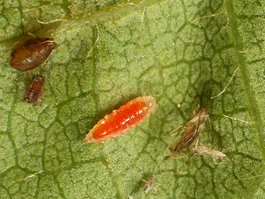by Geraldine Warner, originally published 1993
Aphidoletes aphidimyza (Rondani)
Anthrocnodax sp.
(Diptera: Cecidomyiidae)

Most species of cecidomyiid flies (or gall gnats) are plant feeders that produce galls in which their larvae live, but a few species are predaceous. Predaceous species are common and reliable predators in the eastern United States and Midwest but appear to be more sporadic in Pacific Northwest orchards. The most abundant species is the aphid predator Aphidoletes aphidimyza. Like other cecidomyiids, A. aphidimyza pupates in moist soil and its scarcity in some Northwest orchards may be due to the dry soil surface between irrigations. Another cecidomyiid, Anthrocnodax sp., has been detected feeding on mites in pear orchards.
Hosts
Predaceous cecidomyiid larvae attack aphids, spider mites, eriophyid mites, pear psylla, thrips and scale insects. They also feed on eggs of mealybugs.
Life stages
Egg
The egg is orange, oval and about 1/80 inch (0.3 mm) long.
Larva
The larva is pink or orange and about 1/8 inch (3 mm) long when mature. Its shape is similar to that of a syrphid fly larva.
Adult
The adult is a delicate, light brown fly with long legs and is about 1/16 inch (1.5 mm) long. It is nocturnal and rarely seen.
Life history
Aphidoletes aphidimyza overwinters in the ground as mature larvae or pupae sheltered inside a cocoon. As the weather warms, adults emerge and mate. Females lay eggs either singly or in small clusters among aphid colonies. As larvae are not very mobile, they feed on aphids where the eggs were laid. They suck out the body contents of the aphids. The life cycle from egg laying to adult emergence takes about 18 to 20 days. There are several generations per year.
Monitoring
Cecidomyiid larvae can easily be detected by examining active aphid colonies. The bright pink or orange color makes the predaceous maggots quite visible despite their small size.
Management
In the eastern United States some cecidomyiid species have developed tolerance to organophosphate insecticides and are important predators of aphids in commercial orchards. However, species common in the Pacific Northwest appear to be susceptible to insecticides.
Some species of cecidomyiids are available from biological control insectaries for release in orchards. The efficacy of these species in controlling aphids in Pacific Northwest orchards is unknown.



